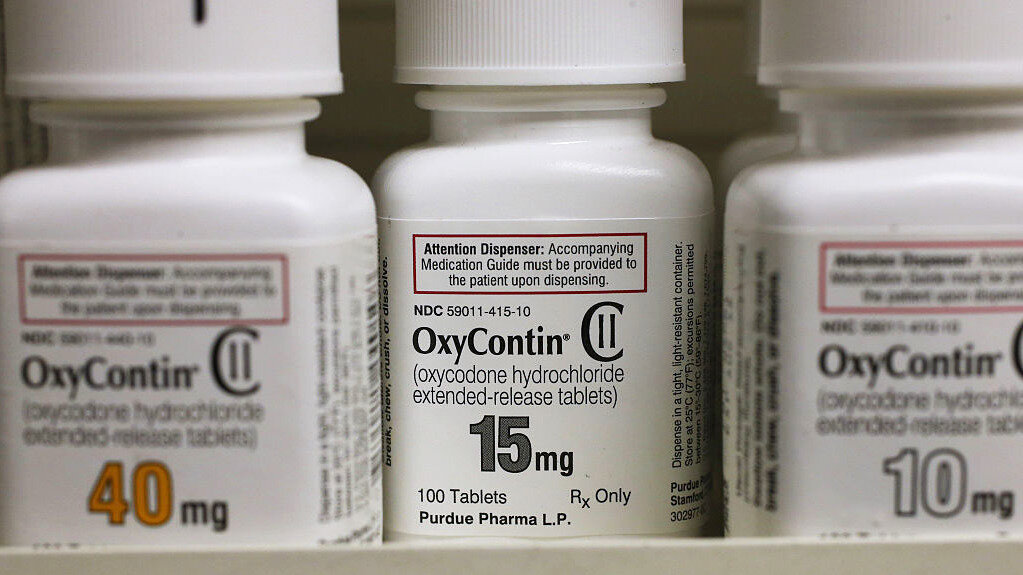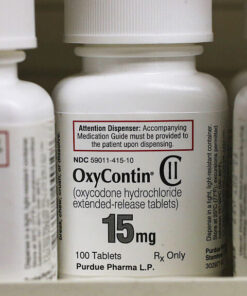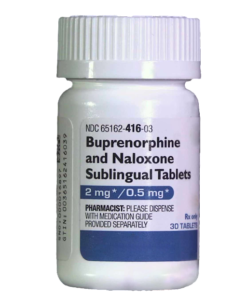OXYCONTIN
$240.00 – $1,200.00Price range: $240.00 through $1,200.00
Oxycontin
Available Dosages: 20mg, 40mg, 60mg and 80mg OC Tablets
Imprints: “OC 20”, “OC 40”, “OC 60”& “OC 80”
Shape/Color: Round Pink/Yellow/Green/Gray/White Pills
Manufacturer: Purdue Pharma LP.
Delivery time:
USA: 8 – 24 hours
Canada: 1 Day to 2 Days
International Delivery: 3 Days to 4 Days
Buy oxycontin online without prescription
Buy oxyContin online from alpha better medications shop because it is an opioid pain medication. An opioid is sometimes called a narcotic.OxyContin is used to treat moderate to severe pain that is expected to last for an extended period of time. OxyContin is used for around-the-clock treatment of pain. It is not to be used on an “as-needed” basis for pain.It should be administered every 12 hours. You should not use OxyContin if you have severe asthma or breathing problems, or a blockage in your stomach or intestines. So place your Order HERE and Buy Oxycontin Online Cheap With Discreet Overnight Delivery.
Uses Of Oxycontin
Oxycontin is basically used for managing mild to moderately severe acute or chronic pain. It has to ameliorate the lifestyle for those suffering from many types of pain. It also helps patients with moderate to severe cancer pain. The controlled release form is a valid alternative to morphine and the first-line treatment for cancer pain. Oxycontin, tends to induce feelings of relaxation and reduced anxiety in those who are occasional users. This makes it one of the most commonly abused drugs in the United States of America. Feel safer to Buy Oxycontin Online without Prescription HERE
CONTRAINDICATIONS
OXYCONTIN is contraindicated in patients with:
- Significant respiratory depression
- Acute or severe bronchial asthma in an unmonitored setting or in the absence of resuscitative equipment
- Known or suspected gastrointestinal obstruction, including paralytic ileus
- Hypersensitivity (e.g., anaphylaxis) to oxycodone
WARNINGS AND PRECAUTIONS
Addiction, Abuse, and Misuse
OXYCONTIN contains oxycodone, a Schedule II controlled substance. As an opioid, OXYCONTIN exposes users to the risks of addiction, abuse, and misuse. Because extended-release products such as OXYCONTIN deliver the opioid over an extended period of time, there is a greater risk for overdose and death due to the larger amount of oxycodone present.
Although the risk of addiction in any individual is unknown, it can occur in patients appropriately prescribed OXYCONTIN. Addiction can occur at recommended doses and if the drug is misused or abused.
Assess each patient’s risk for opioid addiction, abuse, or misuse prior to prescribing OXYCONTIN, and reassess all patients receiving OXYCONTIN for the development of these behaviors and conditions. Risks are increased in patients with a personal or family history of substance abuse (including drug or alcohol abuse or addiction) or mental illness (e.g., major depression). The potential for these risks should not, however, prevent the proper management of pain in any given patient. Patients at increased risk may be prescribed opioids such as OXYCONTIN but use in such patients necessitates intensive counseling about the risks and proper use of OXYCONTIN along with frequent reevaluation for signs of addiction, abuse, and misuse. Consider prescribing naloxone for the emergency treatment of opioid overdose.
Abuse or misuse of OXYCONTIN by crushing, chewing, snorting, or injecting the dissolved product will result in the uncontrolled delivery of oxycodone and can result in overdose and death.
Opioids are sought for nonmedical use and are subject to diversion from legitimate prescribed use. Consider these risks when prescribing or dispensing OXYCONTIN. Strategies to reduce these risks include prescribing the drug in the smallest appropriate quantity and advising the patient on careful storage of the drug during the course of treatment and the proper disposal of unused drug. Contact local state professional licensing board or state-controlled substances authority for information on how to prevent and detect abuse or diversion of this product.
Life-Threatening Respiratory Depression
Serious, life-threatening, or fatal respiratory depression has been reported with the use of opioids, even when used as recommended. Respiratory depression, if not immediately recognized and treated, may lead to respiratory arrest and death. Management of respiratory depression may include close observation, supportive measures, and use of opioid antagonists, depending on the patient’s clinical status. Carbon dioxide (CO2) retention from opioid-induced respiratory depression can exacerbate the sedating effects of opioids.
While serious, life-threatening, or fatal respiratory depression can occur at any time during the use of OXYCONTIN, the risk is greatest during the initiation of therapy or following a dosage increase.
To reduce the risk of respiratory depression, proper dosing and titration of OXYCONTIN are essential. Overestimating the OXYCONTIN dosage when converting patients from another opioid product can result in a fatal overdose with the first dose.
Accidental ingestion of even one dose of OXYCONTIN, especially by children, can result in respiratory depression and death due to an overdose of oxycodone.
Educate patients and caregivers on how to recognize respiratory depression and emphasize the importance of calling 911 or getting emergency medical help right away in the event of a known or suspected overdose.
Opioids can cause sleep-related breathing disorders including central sleep apnea (CSA) and sleep-related hypoxemia. Opioid use increases the risk of CSA in a dose-dependent fashion. In patients who present with CSA, consider decreasing the opioid dosage using best practices for opioid taper.
Patient Access to Naloxone for the Emergency Treatment of Opioid Overdose:
Discuss the availability of naloxone for the emergency treatment of opioid overdose with the patient and caregiver and assess the potential need for access to naloxone, both when initiating and renewing treatment with OXYCONTIN. Inform patients and caregivers about the various ways to obtain naloxone as permitted by individual state naloxone dispensing and prescribing requirements or guidelines (e.g., by prescription, directly from a pharmacist, or as part of a community-based program). Educate patients and caregivers on how to recognize respiratory depression and emphasize the importance of calling 911 or getting emergency medical help, even if naloxone is administered.
Consider prescribing naloxone, based on the patient’s risk factors for overdose, such as concomitant use of CNS depressants, a history of opioid use disorder, or prior opioid overdose. The presence of risk factors for overdose should not prevent the proper management of pain in any given patient. Also consider prescribing naloxone if the patient has household members (including children) or other close contacts at risk for accidental ingestion or overdose. If naloxone is prescribed, educate patients and caregivers on how to treat with naloxone.
Risks from Concomitant Use with Benzodiazepines or Other CNS Depressants
Profound sedation, respiratory depression, coma, and death may result from concomitant use of OXYCONTIN with benzodiazepines and/or other CNS depressants, including alcohol (e.g., non-benzodiazepines sedatives/hypnotics, anxiolytics, tranquilizers, muscle relaxants, general anesthetics, antipsychotics, other opioids). Because of these risks, reserve concomitant prescribing of these drugs for use in patients for whom alternative treatment options are inadequate.
Observational studies have demonstrated that concomitant use of opioid analgesics and benzodiazepines increases the risk of drug-related mortality compared to use of opioid analgesics alone. Because of similar pharmacological properties, it is reasonable to expect similar risk with the concomitant use of other CNS depressant drugs with opioid analgesics.
If the decision is made to prescribe a benzodiazepine or other CNS depressant concomitantly with an opioid analgesic, prescribe the lowest effective dosages and minimum durations of concomitant use. In patients already receiving an opioid analgesic, prescribe a lower initial dose of the benzodiazepine or other CNS depressant than indicated in the absence of an opioid, and titrate based on clinical response. If an opioid analgesic is initiated in a patient already taking a benzodiazepine or other CNS depressant, prescribe a lower initial dose of the opioid analgesic, and titrate based on clinical response. Inform patients and caregivers of this potential interaction and educate them on the signs and symptoms of respiratory depression (including sedation).
If concomitant use is warranted, consider prescribing naloxone for the emergency treatment of opioid overdose.
Advise both patients and caregivers about the risks of respiratory depression and sedation when OXYCONTIN is used with benzodiazepines or other CNS depressants (including alcohol and illicit drugs). Advise patients not to drive or operate heavy machinery until the effects of concomitant use of the benzodiazepine or other CNS depressant have been determined. Screen patients for risk of substance use disorders, including opioid abuse and misuse, and warn them of the risk for overdose and death associated with the use of additional CNS depressants including alcohol and illicit drugs.
Neonatal Opioid Withdrawal Syndrome
Use of OXYCONTIN for an extended period of time during pregnancy can result in withdrawal in the neonate. Neonatal opioid withdrawal syndrome, unlike opioid withdrawal syndrome in adults, may be life-threatening if not recognized and treated, and requires management according to protocols developed by neonatology experts. Observe newborns for signs of neonatal opioid withdrawal syndrome and manage accordingly. Advise pregnant women using opioids for an extended period of time of the risk of neonatal opioid withdrawal syndrome and ensure that appropriate treatment will be available.
Risks of Concomitant Use or Discontinuation of Cytochrome P450 3A4 Inhibitors and Inducers
Concomitant use of OXYCONTIN with a CYP3A4 inhibitor, such as macrolide antibiotics (e.g., erythromycin), azole-antifungal agents (e.g., ketoconazole), and protease inhibitors (e.g., ritonavir), may increase plasma concentrations of oxycodone and prolong opioid adverse reactions, which may cause potentially fatal respiratory depression, particularly when an inhibitor is added after a stable dose of OXYCONTIN is achieved. Similarly, discontinuation of a CYP3A4 inducer, such as rifampin, carbamazepine, and phenytoin, in OXYCONTIN-treated patients may increase oxycodone plasma concentrations and prolong opioid adverse reactions. When using OXYCONTIN with CYP3A4 inhibitors or discontinuing CYP3A4 inducers in OXYCONTIN-treated patients, evaluate patients at frequent intervals and consider dosage reduction of OXYCONTIN until stable drug effects are achieved.
Concomitant use of OXYCONTIN with CYP3A4 inducers or discontinuation of a CYP3A4 inhibitor could decrease oxycodone plasma concentrations, decrease opioid efficacy or, possibly, lead to a withdrawal syndrome in a patient who had developed physical dependence to oxycodone. When using OXYCONTIN with CYP3A4 inducers or discontinuing CYP3A4 inhibitors, evaluate patients at frequent intervals and consider increasing the opioid dosage if needed to maintain adequate analgesia or if symptoms of opioid withdrawal occur.
Opioid-Induced Hyperalgesia and Allodynia
Opioid-Induced Hyperalgesia (OIH) occurs when an opioid analgesic paradoxically causes an increase in pain, or an increase in sensitivity to pain. This condition differs from tolerance, which is the need for increasing doses of opioids to maintain a defined effect. Symptoms of OIH include (but may not be limited to) increased levels of pain upon opioid dosage increase, decreased levels of pain upon opioid dosage decrease, or pain from ordinarily non-painful stimuli (allodynia). These symptoms may suggest OIH only if there is no evidence of underlying disease progression, opioid tolerance, opioid withdrawal, or addictive behavior.
Cases of OIH have been reported, both with short-term and longer-term use of opioid analgesics. Though the mechanism of OIH is not fully understood, multiple biochemical pathways have been implicated. Medical literature suggests a strong biologic plausibility between opioid analgesics and OIH and allodynia. If a patient is suspected to be experiencing OIH, carefully consider appropriately decreasing the dose of the current opioid analgesic or opioid rotation (safely switching the patient to a different opioid moiety).
Life-Threatening Respiratory Depression in Patients with Chronic Pulmonary Disease or in Elderly, Cachectic, or Debilitated Patients
The use of OXYCONTIN in patients with acute or severe bronchial asthma in an unmonitored setting or in the absence of resuscitative equipment is contraindicated.
Patients with Chronic Pulmonary Disease: OXYCONTIN-treated patients with significant chronic obstructive pulmonary disease or cor pulmonale, and those with a substantially decreased respiratory reserve, hypoxia, hypercapnia, or pre-existing respiratory depression are at increased risk of decreased respiratory drive including apnea, even at recommended dosages of OXYCONTIN.
Elderly, Cachectic, or Debilitated Patients: Life-threatening respiratory depression is more likely to occur in elderly, cachectic, or debilitated patients because they may have altered pharmacokinetics or altered clearance compared to younger, healthier patients. Regularly evaluate patients, particularly when initiating and titrating OXYCONTIN and when OXYCONTIN is given concomitantly with other drugs that depress respiration. Alternatively, consider the use of non-opioid analgesics in these patients.
Adrenal Insufficiency
Cases of adrenal insufficiency have been reported with opioid use, more often following greater than one month of use. Presentation of adrenal insufficiency may include non-specific symptoms and signs including nausea, vomiting, anorexia, fatigue, weakness, dizziness, and low blood pressure. If adrenal insufficiency is suspected, confirm the diagnosis with diagnostic testing as soon as possible. If adrenal insufficiency is diagnosed, treat with physiologic replacement doses of corticosteroids. Wean the patient off of the opioid to allow adrenal function to recover and continue corticosteroid treatment until adrenal function recovers. Other opioids may be tried as some cases reported use of a different opioid without recurrence of adrenal insufficiency. The information available does not identify any particular opioids as being more likely to be associated with adrenal insufficiency.
Severe Hypotension
OXYCONTIN may cause severe hypotension, including orthostatic hypotension and syncope in ambulatory patients. There is an increased risk in patients whose ability to maintain blood pressure has already been compromised by a reduced blood volume or concurrent administration of certain CNS depressant drugs (e.g., phenothiazines or general anesthetics). Regularly evaluate these patients for signs of hypotension after initiating or titrating the dosage of OXYCONTIN. In patients with circulatory shock, OXYCONTIN may cause vasodilation that can further reduce cardiac output and blood pressure. Avoid the use of OXYCONTIN in patients with circulatory shock.
Risks of Use in Patients with Increased Intracranial Pressure, Brain Tumors, Head Injury, or Impaired Consciousness
In patients who may be susceptible to the intracranial effects of CO2 retention (e.g., those with evidence of increased intracranial pressure or brain tumors), OXYCONTIN may reduce respiratory drive, and the resultant CO2 retention can further increase intracranial pressure. Monitor such patients for signs of sedation and respiratory depression, particularly when initiating therapy with OXYCONTIN.
Opioids may also obscure the clinical course in a patient with a head injury. Avoid the use of OXYCONTIN in patients with impaired consciousness or coma.
Difficulty in Swallowing and Risk for Obstruction in Patients at Risk for a Small Gastrointestinal Lumen
There have been post-marketing reports of difficulty in swallowing OXYCONTIN tablets. These reports included choking, gagging, regurgitation and tablets stuck in the throat. Instruct patients not to pre-soak, lick, or otherwise wet OXYCONTIN tablets prior to placing in the mouth, and to take one tablet at a time with enough water to ensure complete swallowing immediately after placing in the mouth.
There have been rare post-marketing reports of cases of intestinal obstruction, and exacerbation of diverticulitis, some of which have required medical intervention to remove the tablet. Patients with underlying GI disorders such as esophageal cancer or colon cancer with a small gastrointestinal lumen are at greater risk of developing these complications. Consider use of an alternative analgesic in patients who have difficulty swallowing and patients at risk for underlying GI disorders resulting in a small gastrointestinal lumen.
Risks of Use in Patients with Gastrointestinal Conditions
OXYCONTIN is contraindicated in patients with known or suspected gastrointestinal obstruction, including paralytic ileus.
The oxycodone in OXYCONTIN may cause spasm of the sphincter of Oddi. Opioids may cause increases in the serum amylase. Regularly evaluate patients with biliary tract disease, including acute pancreatitis, for worsening symptoms.
Increased Risk of Seizures in Patients with Seizure Disorders
The oxycodone in OXYCONTIN may increase the frequency of seizures in patients with seizure disorders and may increase the risk of seizures occurring in other clinical settings associated with seizures. Regularly evaluate patients with a history of seizure disorders for worsened seizure control during OXYCONTIN therapy.
Withdrawal
Do not abruptly discontinue OXYCONTIN in a patient physically dependent on opioids. When discontinuing OXYCONTIN in a physically dependent patient, gradually taper the dosage. Rapid tapering of oxycodone in a patient physically dependent on opioids may lead to a withdrawal syndrome and return of pain.
Additionally, avoid the use of mixed agonist/antagonist (e.g., pentazocine, nalbuphine, and butorphanol) or partial agonist (e.g., buprenorphine) analgesics in patients who are receiving a full opioid agonist analgesic, including OXYCONTIN. In these patients, mixed agonist/antagonist and partial agonist analgesics may reduce the analgesic effect and/or may precipitate withdrawal symptoms.
Risks of Driving and Operating Machinery
OXYCONTIN may impair the mental or physical abilities needed to perform potentially hazardous activities such as driving a car or operating machinery. Warn patients not to drive or operate dangerous machinery unless they are tolerant to the effects of OXYCONTIN and know how they will react to the medication.
Laboratory Monitoring
Not every urine drug test for “opioids” or “opiates” detects oxycodone reliably, especially those designed for in-office use. Further, many laboratories will report urine drug concentrations below a specified “cut-off” value as “negative”. Therefore, if urine testing for oxycodone is considered in the clinical management of an individual patient, ensure that the sensitivity and specificity of the assay is appropriate, and consider the limitations of the testing used when interpreting results.
ADVERSE REACTIONS
OXYCONTIN may increase the risk of serious adverse reactions such as those observed with other opioid analgesics, including respiratory depression, apnea, respiratory arrest, circulatory depression, hypotension, or shock.
The most common adverse reactions (≥5%) reported by adult patients in clinical trials comparing OXYCONTIN with placebo are constipation, nausea, somnolence, dizziness, pruritus, vomiting, headache, dry mouth, asthenia, and sweating.
DRUG INTERACTIONS
Clinically significant drug interactions with OXYCONTIN include:
Inhibitors of CYP3A4 and CYP2D6: The concomitant use of OXYCONTIN and CYP3A4 inhibitors can increase the plasma concentration of oxycodone, resulting in increased or prolonged opioid effects. These effects could be more pronounced with concomitant use of OXYCONTIN and CYP2D6 and CYP3A4 inhibitors, particularly when an inhibitor is added after a stable dose of OXYCONTIN is achieved.
After stopping a CYP3A4 inhibitor, as the effects of the inhibitor decline, the oxycodone plasma concentration will decrease, resulting in decreased opioid efficacy or a withdrawal syndrome in patients who had developed physical dependence to oxycodone.
CYP3A4 Inducers: The concomitant use of OXYCONTIN and CYP3A4 inducers can decrease the plasma concentration of oxycodone, resulting in decreased efficacy or onset of a withdrawal syndrome in patients who have developed physical dependence to oxycodone.
After stopping a CYP3A4 inducer, as the effects of the inducer decline, the oxycodone plasma concentration will increase, which could increase or prolong both the therapeutic effects and adverse reactions and may cause serious respiratory depression.
Benzodiazepines and Other Central Nervous System (CNS) Depressants: Due to additive pharmacologic effect, the concomitant use of benzodiazepines or other CNS depressants, including alcohol, can increase the risk of hypotension, respiratory depression, profound sedation, coma, and death.
Serotonergic Drugs: The concomitant use of opioids with other drugs that affect the serotonergic neurotransmitter system has resulted in serotonin syndrome.
Monoamine Oxidase Inhibitors (MAOIs): MAOI interactions with opioids may manifest as serotonin syndrome or opioid toxicity (e.g., respiratory depression, coma).
Mixed Agonist/Antagonist and Partial Agonist Opioid Analgesics: May reduce the analgesic effect of OXYCONTIN and/or precipitate withdrawal symptoms.
Muscle Relaxants: Oxycodone may enhance the neuromuscular blocking action of skeletal muscle relaxants and produce an increased degree of respiratory depression.
Diuretics: Opioids can reduce the efficacy of diuretics by inducing the release of antidiuretic hormone.
Anticholinergic Drugs: The concomitant use of anticholinergic drugs may increase risk of urinary retention and/or severe constipation, which may lead to paralytic ileus.
Best Place To Buy Oxycontin Online Cheap – Without Prescription
At Alpha Better Medication shop is simply the best place to buy Oxycontin Online Without Prescription safe and secure. Products are of the best quality from FDA Approved facilities. Packaging is safe and shipping is 100% discreet. We offer the fastest delivery ever From the USA to all the parts of the world. We ship with various services like DHL, FedEx, UPS and TNT for now. Feel safer than ever to place your order here.
| OXYCONTIN | 60 pills of 20 mg at $4.00/pill, 60 pills of 80 mg at $7.00/pill, 60 pills of 40 mg at $6.00/pill, 90 pills of 40 mg at $5.50/pill, 90 pills of 80 mg at $6.50/pill, 90 pills of 20 mg at $3.50/pill, 120 pills of 40 mg at $5.00/pill, 120 pills of 20 mg at $3.00/pill, 120 pills of 80 mg at $6.00, 180 pills of 80 mg at $5.50/pill, 180 pills of 20 mg at $2.50/pill, 180 pills of 40 g at $4.50/pill, 240 pills of 40 mg at $4.00/pill, 240 pills of 20 mg at $2.00/pill, 240 pills of 80 mg at $5.00/pill |
|---|
















Reviews
There are no reviews yet.